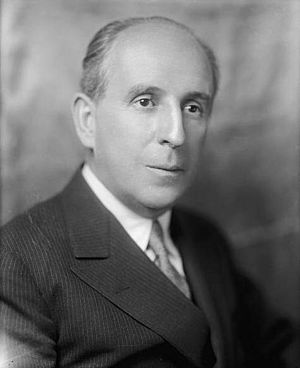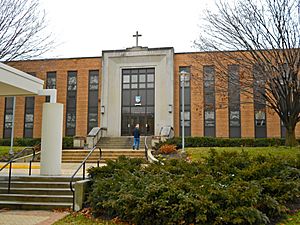Archmere Academy facts for kids
Quick facts for kids Archmere Academy |
|
|---|---|
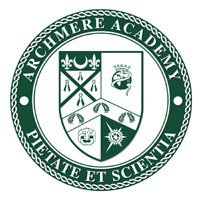
Archmere Academy school crest
|
|
| Address | |
|
3600 Philadelphia Pike
, New Castle County
,
Delaware
19703
United States
|
|
| Coordinates | 39°48′07″N 75°27′18″W / 39.80194°N 75.45500°W |
| Information | |
| Type | Private, coeducational |
| Motto | Pietate et Scientia (Faith and Knowledge) |
| Religious affiliation(s) | Roman Catholic |
| Denomination | Norbertine |
| Established | 1932 |
| CEEB code | 080010 |
| Rector | Rev. Fr. Joseph McLaughlin, O. Praem |
| Principal | Katie Eissler Thiel |
| Headmaster | Michael Marinelli |
| Chaplain | Father John Zagarella |
| Grades | 9-12 |
| Enrollment | 514 (2020–21) |
| Average class size | 15 |
| Student to teacher ratio | 6:1 |
| Color(s) | Green and white |
| Mascot | Great auk |
| Nickname | Auks |
| Accreditation | Middle States Association of Colleges and Schools |
| Publication | Tapestry |
| Newspaper | The Green Arch |
| Yearbook | The Patio |
| Tuition | Approximately $34,100 |
Archmere Academy is a private Catholic school in Claymont, Delaware, United States. It helps students get ready for college. In the 2020-2021 school year, 514 students attended. Archmere Academy teaches both boys and girls. It is an independent school, but it is part of the Diocese of Wilmington.
Contents
History of Archmere Academy
Archmere Academy was started in 1932 by a group of priests called the Norbertines. At first, it was only for boys. The school is located on what used to be the large home of a businessman named John J. Raskob. He lived there with his wife Helena and their 12 children until 1931. Mr. Raskob was involved in politics. His home was used for many important meetings.
In 1932, Bernard Pennings bought the estate. He was the leader of the Norbertine Order. He also started St. Norbert College in Wisconsin. The estate was bought for $300,000 in the spring of 1932. The school officially opened in the fall of 1932. In its first year, Archmere Academy had 22 students. By 1934, the number of students grew to 72.
Archmere Academy slowly grew in the late 1930s as more students joined. Small changes were made to make space for students who lived at the school. In 1939, the school built its first gym. By 1940, the main house on the property was turned into a science center. In the mid-1940s, the school became a four-year high school. It stopped teaching 7th and 8th grades in 1946 and 1947. It continued as a school for boys, where some students lived there and others just came for the day.
In 1957, Archmere Academy celebrated its 25th birthday. They started building St. Norbert Hall, which is the school's main academic building. It was finished in 1959. In the 1960s, the school kept growing. By the end of that decade, 394 students were enrolled. The Justin E. Diny Science Center opened in 1973. It had classrooms for physics, chemistry, biology, and environmental science. The old science center became an arts center. It held classes for chorus, band, theater, and art.
The 1970s brought two big changes to Archmere Academy. First, it stopped being a boarding school. All students became day students. Second, in 1975, the school decided to allow girls to attend. They welcomed 50 girls into the school. Around the end of the 1970s, a group of people called a board of trustees was formed for the school. Their first meeting was in 1980. This board helped add more classes and after-school activities. They also helped expand the school buildings. This included adding to St. Norbert Hall. In the early 1980s, a new auditorium that could seat 750 people was built. A new library was also built on campus.
In 2001, there was a disagreement among the Norbertine priests. This affected the school's management. But former students helped calm things down. As a result, the school took control of the old Raskob home, which is called "the Patio." In 2003, the school started a campaign to improve its buildings. This included expanding the Justin E. Diny Science Center, building a student life center, and fixing up the athletic fields.
In 2010, Dr. Michael Marinelli became the headmaster. He was the first headmaster who was not a Norbertine priest. He had graduated from Archmere Academy in 1976.
Towards the end of the 2015-2016 school year, Archmere began big renovations on Saint Norbert's Hall. This project changed the library and every room in the building.
School Buildings and Design
|
Archmere
|
|
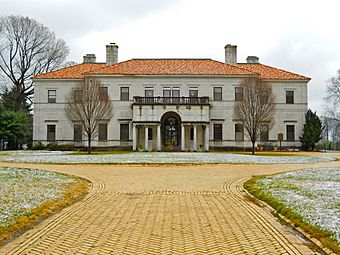
The Patio, country estate of John J. Raskob
|
|
| Location | 3600 Philadelphia Pike, Claymont, Delaware |
|---|---|
| Area | 15 acres (6.1 ha) |
| Architect | Harper, Alexander James; McCure, Clay |
| Architectural style | Renaissance, Italian Renaissance |
| NRHP reference No. | 92001143 |
| Added to NRHP | September 9, 1992 |
The Patio is one of the buildings at Archmere Academy. It was built between 1916 and 1918. It was originally the country home of John J. Raskob and his wife. Mr. Raskob was a financial expert. He also helped build the Empire State Building. The name "Archmere" was given to the estate because of the natural arch of trees that looked out over the Delaware River. The original Patio building was added to the National Register of Historic Places in 2007. This means it is a special historical site. In 2009, the Delaware Public Archives placed a historical marker at Archmere Academy.
What Students Learn at Archmere
Archmere students must take many different classes. These include eight semesters of English, seven semesters of religion, and six semesters each of mathematics, foreign language, history, and science. Students can also choose elective classes. These include art, yearbook (which is a class), band, chorus, and computer classes.
Archmere offers many AP courses. These are advanced classes that can earn you college credit. Some AP courses offered are Spanish, French, statistics, calculus, physics, chemistry, biology, environmental science, art, computer science, English, US history, European history, and world history.
Music Program
The music program at Archmere Academy is an elective. This means students can choose to take it. It focuses on different types of music, from old Renaissance music to modern jazz and Broadway songs. Students learn mostly by practicing and performing. There is also a music theory class for advanced students. A songwriting class is also available.
Performing groups include the jazz ensemble, concert choir, stage band, and Mastersingers. The Mastersingers group started in 1988. It has 30 students who are chosen by audition. They perform at school events and community concerts. They also compete in national and international competitions. The school also has a special program where student musicians can study with the Serafin String Quartet.
Sports at Archmere
Archmere competes in the Diamond State Conference for school sports. These sports include American football, field hockey, basketball, rugby, soccer, swimming, diving, lacrosse, volleyball, golf, tennis, cheerleading, baseball, softball, cross country, track and field and wrestling.
The Archmere campus has two artificial turf fields. These are used for football, soccer, lacrosse, and field hockey. There is also a baseball field and a softball field, both with dugouts. The campus also has six tennis courts and a running track.
Archmere has won many DIAA championships. These include cross country, volleyball, and rugby. From 1991 to 2013, Archmere won eight cross country championships. They were also runner-up seven times. The girls' volleyball team won the championship in 2014. They won again in 2015, but lost in the finals. The rugby team won three state titles in a row in 2015, 2016, and 2017. They won again in 2019. The boys' soccer team won the school's first state title in soccer in 2019. They finished the season with 17 wins and only 1 loss. The rugby team continued to do well in 2021. They were undefeated and won the 2021 Delaware 7s state title. In 2023, the Archmere rugby team won another exciting game to get their third title in five years.
In the 1960 season, Archmere's football team had a perfect season, winning all 8 games. This was after 12 years of losing seasons. The team was led by a star athlete named Joe Biden. He later became the 46th President of the United States.
In the 2021 football season, Archmere's varsity team was undefeated with a record of 13 wins and 0 losses. They won their district and the Class 2A State Championship. The junior varsity (JV) team also had a perfect season, winning all 5 of their games.
In the 2022 Field Hockey season, Archmere's Varsity team reached the DII State Championship for the first time in 23 years. The team had 13 wins and 2 losses in the regular season. Five players from the team were named All-State players.
In the 2022-2023 Girls Soccer Season, Archmere's varsity team won an amazing game against St. Marks. They defeated them 6-1 in the DII State Championship game. This was the first time the girls' soccer team won the championship in the school's history.
Famous Archmere Alumni
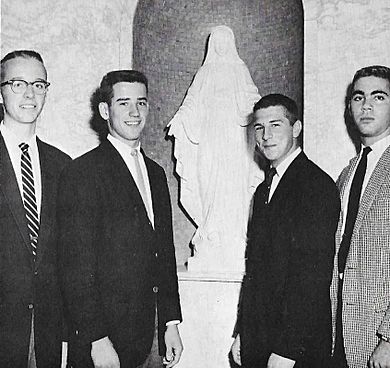
Many notable people have graduated from Archmere Academy. They are called "Archmereans."
- Joe Biden (Class of 1961) – He was the 46th President of the United States from 2021 to 2025. He was also the 47th Vice President of the United States from 2009 to 2017. Before that, he was a United States Senator for Delaware for many years.
- Nick Romano (Class of 1963) – He received a Purple Heart for his service in the Vietnam War.
- Colm Connolly (born 1964) – He is a Chief United States District Judge in Delaware.
- Dominic Pileggi (Class of 1975) – A politician from Pennsylvania.
- Stefan Roots – The Mayor of Chester, Pennsylvania.
- William H. Green (Class of 1979) – A chemical engineer and professor at MIT.
- Mark T. Smith (Class of 1986) – A painter known for his colorful art.
- Beau Biden (Class of 1987) – He was the Attorney General for Delaware. He was also the son of Joe Biden.
- Hunter Biden (Class of 1988) – A lawyer and lobbyist. He is also the son of Joe Biden.
- Erin Arvedlund (Class of 1988) – A financial journalist who has written for many well-known newspapers.
- Meagan Miller (Class of 1992) – An American singer who performs in opera and concerts around the world.
- Tom Coyne (Class of 1993) – A writer and professor of English.
- Ashley Biden (Class of 1999) – An activist and daughter of Joe Biden.


